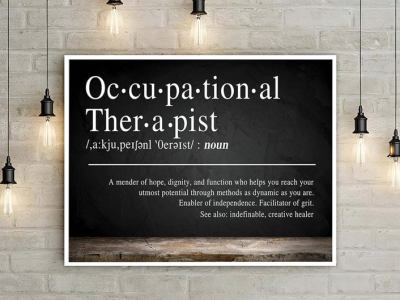
I just love this sign. Facilitator of grit, creative healer… makes me feel like perhaps I do have superpowers after all! In general, occupational therapy (OT) aims to promote wellness and rehabilitation with a focus on meaningful activities, or tasks you perform daily in order to care for yourself. We specialize in the upper extremities and how fine motor deficits can impact your self care. Occupational therapy is provided through many different settings (hospitals, rehabs, outpatient and home) as well as age/specialty groups (pediatrics, geriatrics, workers comp, veterans). For the purpose of this introduction to OT, lets focus on the aging in place cohort of folks I am aiming to work with!
“I don’t need a job, I’m retired!” Pete says as he winks at his wife and we all giggle. I’ve heard this on many occasions and it still makes me smirk. Ideally, the term occupational therapy should create a spectrum of visions in your noggin. We all have a primary occupation, or daily job to do in taking care of ourselves. Our most primary and basic tasks we do on a daily basis includes eating, dressing, toileting, grooming, bathing, along with our form of movement to get there. We call these daily tasks our activities of daily living, and our mobility in how we do them is referred to as functional mobility. The goal of a good home health occupational therapist is to teach the client how to perform these activities of daily living, using the ideal method of functional mobility, in the most independent and safe manner possible. It is also especially important for the caregivers & family members to be taught how to support and assist these clients. For many spouses and children, this role of caregiver is new to them and they should have support and guidance in learning how to excel at this new role.
Occupational therapy has evolved through the years. Once known primarily as helping people do crafting activities, the scope of practice is wide and can be applied in limitless ways. From teaching how to cope with disease or injury, to learning a new role of caregiver, to breathing exercises with mobility, to making your home more safe for you to age in place, occupational therapy is the only known spending category that reduces hospital readmissions.
OTs have extensive training and knowledge in psychology, disease prevention, anatomy, strengthening, cognitive decline and home safety. Tie all this together with the individuals past medical history and current situation and we can begin to see how occupational therapy can be quite unique to each client. That being said, the role OTs play in helping seniors in the home can be vital for those who desire to “age in place” or stay at home, as safely and as long as possible.
Home safety and fall prevention is a critical first step in any home care plan. Discussing change can be difficult, but when the aim is to keep you safe and where you want to be, it’s a little easier to swallow. Home safety recommendations, medical equipment recommendations and training in use of equipment are all included in the first steps in fall prevention. Occupational therapists are the experts in this arena!

